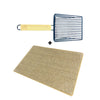While watching your cat scratch up a favorite piece of furniture, a portion of the floor, or even your arms or legs can be extremely frustrating, a growing body of evidence shows that the long term effects of this surgical procedure can be devastating to your furry feline(s).
Cats instinctively keep their claws (and bodies) healthy by scratching. They use their claws to engage in nearly every daily activity from jumping and playing to climbing and stretching. Before declawing becomes part of the conversation, let’s consider the implications of this elective, painful, and most-often unnecessary surgery.
The process of declawing involves amputating the last bone at the tips of a feline’s toes. This procedure is equivalent to removing the first knuckles of your fingers. Not a fun thought, right? Not only are there severe risks to your pet during the actual procedure, but claw removal can cause chronic pain and a host of other long term problems. When felines are in pain, it can manifest in many ways - usually through potty problems, excessive licking, chewing on paws and fur, aggression, biting, and limping while walking or jumping. One recent study found declawed cats in multi-cat homes to be three times more likely to soil the house instead of using a litterbox than those with intact claws. The surgical risks alone include chance of infection, tissue necrosis, lameness, and an increased risk of back pain and bone deformity.
Declawing is currently illegal in New York and Maryland unless deemed necessary for a therapeutic purpose. Numerous U.S. cities currently have declawing bans in place with many more considering the ban. This movement is gaining momentum and is currently illegal in several countries.
Why Do Cats Scratch?
Scratching is a natural, healthy behavior used for many purposes. When cats scratch, they are able to stretch their muscles and joints in their backs, legs, and paws. Territories are also communicated to other cats in a multi-cat home by signaling their presence through scratching. Leaving their scent in specific places throughout your home allows your cat to feel secure knowing they have a safe place all to their own.
Redirecting the Behavior:
While we should never ask our cats to stop scratching completely, we can offer them several alternative options for this desired behavior.
- Provide a scratching post placed near your pet’s favorite sleeping spot and/or near a place they have been known to scratch. Once the behavior of scratching on the post becomes routine, it can be moved to other areas of the home. Make sure the post is tall and secure for best results. Multisurface scratching posts offering a variety of textures will stimulate instincts to scratch.
- Scratching posts aren’t the only option. There are many scratching surfaces available that are not only creative and stimulating for your feline, but also suitable for any space within your home.
- Get creative and make your own scratching post - your furry friend will love it all the same!
- If your pet needs a little enticing to scratch a desired surface, rub catnip on the item, whether it’s a scratching post, claw-safe bed, favorite blanket, or toy. Make sure to provide positive reinforcement when used correctly. Cats can be trained, it just takes a little time and patience.
Additionally, there are many products to aid in your decision to keep your cat’s claws intact. Nail clippers and grinders used properly and frequently can cut down on excessive scratching. Nail caps can be applied safely to your cat’s claws and offer a safe and humane solution to scratching problems. Most cats do not even know they are wearing them and they come in a variety of fun colors, even glow-in-the-dark varieties! Many scratching deterrents such as scratching sprays and furniture shields are also available to redirect behavior and protect your furnishings in the process.
Until recent years, most people—including animal lovers—did not realize the implications of declawing a cat. By educating cat owners about the painful and often life-changing effects of declawing, we can save many cats from the procedures' painful effects. With a little patience and positive reinforcement, your cat can be trained to scratch in appropriate places while fulfilling a natural and healthy instinct.
For more information and to join the conversation, consider joining The Paw Project, a non-profit organization working to end the cruel and unnecessary practice of feline declawing.














